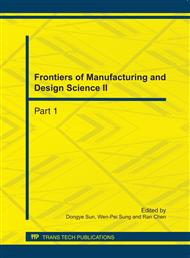p.4377
p.4382
p.4386
p.4391
p.4396
p.4405
p.4410
p.4415
p.4421
Application of Visualized Design Method on the Designing of Articulatory Vibrating Screen
Abstract:
Articulatory vibrating screen is composed of multi-section screen with articulatory vibrating. The principle of even-thickness screening is referenced on its layout, with linear vibrating screen as the discharge end, with round vibrating screens as the feeding end, and also the intermediate screen. In accordance with the structural features of articulatory vibrating screen and under the condition of assembly module in Pro/E, mechanical components of articulatory vibrating screen are assembled in the light of the arrangement, the sequence, the restrictions and the modifications of installation. With the visualized research on the operational process, the three-dimensional illustrations of assembly model are established to ensure the correct design on every mechanical component of articulatory vibrating screen. The finite element model of vibrating screen is set up by its analysis software to carry out the analysis of finite element calculation and modal according to two operating modes of the regular work and the machine halt beyond resonance region. The analysis result indicates that the intensity and the rigidity of the vibrating screen are safe; the machine operation is stable; and no resonance phenomenon would happen. This study provides the theoretical reference for the design of similar machinery. It is of practical importance and economic value to apply the visualized design method into the design of articulatory vibrating screen.
Info:
Periodical:
Pages:
4396-4404
Citation:
Online since:
October 2011
Authors:
Price:
Сopyright:
© 2012 Trans Tech Publications Ltd. All Rights Reserved
Share:
Citation:


